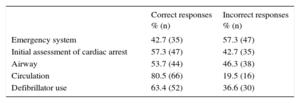Out-of-hospital cardiac arrest (CA) is a major public health problem. More than 24 500 CAs are estimated to occur in Spain, equivalent to a CA every 20minutes and causing 4 times more deaths than traffic accidents.1 In Europe, CAs are thought to affect 700 000 individuals.2 Saving lives does not only depend on high-quality cardiopulmonary resuscitation (CPR) but also on appropriate training for the population. Any event outside normal in Spain activates the emergency services. Depending on the organizational structure of the emergency services in each autonomous region, local police may be the first to arrive on the scene of a CA.
Local police, as the first on the scene, are responsible for carrying out the first 3 steps in the chain of survival: a) early recognition of the medical emergency and activation of the emergency response system; b) early CPR, and c) early defibrillation, according to the recommendations of the European Council for Resuscitation and the American Heart Association.3
The objective of the present study was to analyze the level of training of local police officers for participation in CPR and use of a semiautomatic external defibrillator (SAED). In this descriptive cross-sectional study, local police officers were chosen at random from 2 municipalities covering 70 614 inhabitants and with a headcount of 104 local police officers. A questionnaire,4 based on the most recent recommendations of the European Resuscitation Council and the American Heart Association,3 was completed anonymously and voluntarily. The questionnaire had multiple-choice answers to specific questions about CPR and SAED, divided into 5 knowledge sections: a) emergency system; b) initial assessment of cardiopulmonary arrest; c) airways; d) circulation, and e) use of SAED (Figure). Epidemiological data such as age, sex, length of service, and number of CPR courses taken were recorded. The data were analyzed using the statistical package SPSS 20.0 for Windows.
Of the 104 questionnaires initially distributed, 82 were completed. The mean age of those surveyed was 44±7 years and 89% were men and 11% women. The mean duration of service as local police officers was 18.6±9.3 years and 73.2% had attended at least 1 CPR course while 26.8% had not attended such a course. Of the 60 local police officers who took at least 1 CPR course, the mean number of such courses was 2±1.5.
The Table shows the overall findings of the survey with regards the specific questions about CPR and SAED. In the specific questionnaire, in the section referring to the emergency system, 42.7% of the local police officers knew what information to provide on activating the emergency system in the face of a medical emergency and that this should be the first action in this situation. In the section about initial CA assessment, 57.3% of the local police officers knew what should be the first action in a CA and knew how to check for consciousness.
Results of the Survey on Specific Questions Referring to Cardiopulmonary Resuscitation and Semiautomatic External Defibrillators
| Correct responses % (n) | Incorrect responses % (n) | |
|---|---|---|
| Emergency system | 42.7 (35) | 57.3 (47) |
| Initial assessment of cardiac arrest | 57.3 (47) | 42.7 (35) |
| Airway | 53.7 (44) | 46.3 (38) |
| Circulation | 80.5 (66) | 19.5 (16) |
| Defibrillator use | 63.4 (52) | 36.6 (30) |
In the section about airway knowledge, 53.7% of those surveyed knew what maneuver to perform to clear the airway; knew the utility of look, listen, feel; knew what to do after the first ventilation if the chest is still not moving, knew how to check for breathing; and knew what to do with an unconscious person who is not breathing. In the section about knowledge of circulation, 80.5% knew how to proceed if an SAED was not available if there was a CA, knew what to perform if the individual with a CA has a perioral lesion, and knew how to place their hands to perform the CPR maneuver. In the section on knowledge about SAED, 63.4% knew how to position the pads and use them, knew not to touch the victim during discharge, and knew what to do when the device is switched on.
Our study provides original information because we have found no other Spanish study that has assessed the level of knowledge about CRP and SAED in a group of local police officers. We cannot, therefore, compare our findings with those on other police forces and security forces in Spain. According to the resuscitation guidelines for 2015, it is very important to establish training plans for the essential steps in the chain of survival following CA in out-of-hospital environments.3 One of the limitations of the present study, in addition to its small sample size, is the inherent selection bias of the voluntary nature of the survey. Those individuals with greatest interest in the topic would be more likely to respond. In conclusion, we found that training courses did not improve knowledge of CPR and SAED use. This brings into question the quality of these courses. A continuous and useful training is highly important to improve knowledge of the out-of-hospital management of CA.



